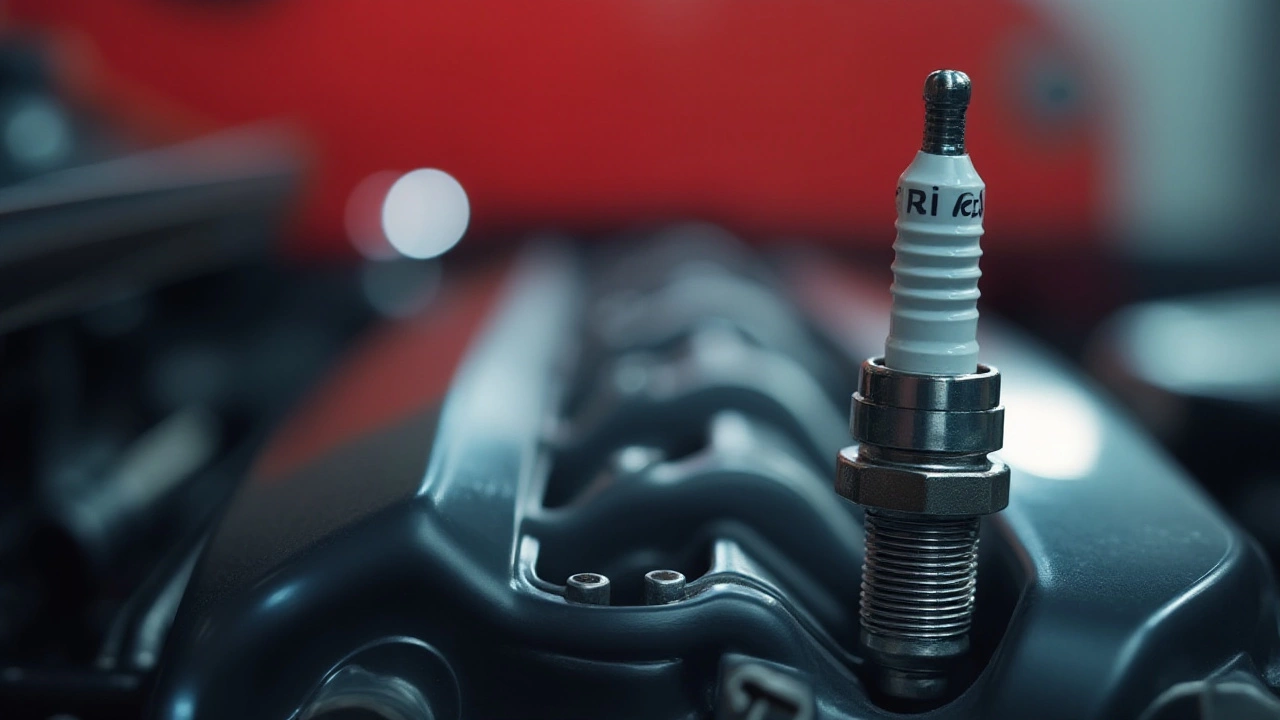 Jan, 16 2025
Jan, 16 2025
If you're the sort of person who loves getting the most out of your vehicle, you've probably thought about all the small adjustments that can make a big difference. One part often overlooked are the spark plugs. These little components play a huge role in how your vehicle performs, especially when it comes to acceleration.
As important as they are, spark plugs don't last forever. Over time, they wear out, leading to weaker engine performance. This decline can affect everything from your fuel efficiency to your car's smoothness on the road. So, could swapping them out for new, improved versions give you that extra zip? Let's delve into why that might just be the case and explore how this simple change could make your driving experience more enjoyable.
- Understanding Spark Plugs
- Signs of Worn-out Spark Plugs
- How Spark Plugs Affect Engine Performance
- Choosing the Right Spark Plugs
- Installation and Maintenance Tips
- Real-World Benefits of Upgrading
Understanding Spark Plugs
At the heart of your car's engine lies a humble yet vital component: the spark plugs. These tiny devices are responsible for igniting the air-fuel mixture within the engine’s cylinders, setting off a series of explosions that power the pistons. Without this spark, your car simply wouldn’t move. For something so small and inexpensive, spark plugs wield tremendous influence over the engine performance. The challenges faced by these little workhorses are numerous. Each spark plug must endure extreme heat and pressure, efficiently directing its sparks across a gap to ignite the air and fuel within fractions of a second. They’re a testament to precise engineering, often crafted from materials like iridium or platinum to withstand years of relentless use.
The science behind spark plugs is fascinating. When the high voltage produced by the ignition coil reaches the plug, it jumps the gap between the electrodes, producing a spark that ignites the fuel-air mixture. This controlled detonation is what pushes down the pistons and turns the crankshaft, propelling your vehicle forward. It's a hectic life for a spark plug, firing thousands of times a minute, and yet they’re expected to last for tens of thousands of miles. But what exactly makes a spark plug capable of handling such stress over a long period? Modern spark plugs are built with metals that enhance conductivity and durability, reducing the frequency of replacements and improving engine performance.”
Understanding the lifespan of spark plugs is crucial. Most require replacement between 30,000 to 100,000 miles, depending on their type and the driving conditions. Iridium and platinum plugs, though more costly, offer longer lifespans due to their enhanced wear resistance. These materials also allow for a thinner central electrode, which means a more efficient spark and better ignition of the air-fuel mixture. This efficiency can lead to improved fuel economy, smoother acceleration, and a more reliable start every time you turn the key. As Albert Einstein once pointedly said, "Look deep into nature, and then you will understand everything better," fitting here as these small components mimic the fiery eruptions of natural processes.
"The spark plug remains one of the most abstract components under the hood, but its importance should not be underestimated," notes renowned automotive expert Jeremy Clarkson.
When we delve into the construction and function of spark plugs, we find intricate engineering aiding everyday drives. Each spark plug features a terminal, insulator, ribs for grip, and a hex nut to secure it to the engine. At its core, housed under the metal shell, are twin electrodes. One is the central electrode, insulated by a ceramic covering to bear the brunt of the spark's heat, while the other, the ground electrode, bridges to the engine body. These electrodes define the ‘gap’ through which electricity arcs, igniting the compressed air-fuel mixture.
The journey to improved acceleration begins with understanding the spark plug's essential function and capability. Investing in the correct spark plugs for your vehicle can yield tangible improvements. The blend of innovative materials with technology has given rise to spark plugs that maximize efficiency, reduce emissions, and grant us the thrilling immediacy every driver loves. Taking the time to familiarize yourself with their design and action can significantly enhance how you experience your time on the road. As conditions evolve and new technologies emerge, staying informed about your vehicle’s internals could make all the difference between an ordinary commute and an exhilarating drive.
Signs of Worn-out Spark Plugs
Recognizing the signs of worn-out spark plugs can be crucial in maintaining your vehicle's peak performance. These tiny components might seem small and insignificant, but their impact on how your engine runs is anything but minimal. One of the first indicators that your spark plugs may need attention is a noticeable drop in acceleration. If your car feels sluggish when you press the gas pedal, or if it doesn't respond as quickly as it used to, the spark plugs could be to blame.
Another telltale sign to watch for is a rough idling engine. When parked or waiting at a stoplight, the motor should purr smoothly, without any hiccups or vibrations. However, with worn spark plugs, you might experience an erratic idle or even stalling, which is something no driver wants. This happens because the spark plugs are not igniting the fuel mixture as effectively as they used to, leading to incomplete combustion and misfires.
Fuel efficiency is another area where old spark plugs can really hurt you in the wallet. You might notice you're visiting the gas station more frequently than before. This could be due to the engine not burning fuel as efficiently, often caused by worn-out spark plugs failing to create the proper spark for combustion. In extreme cases, you might even experience difficulty starting your vehicle. This is often one of the last straws of spark plug failure when they've deteriorated to the point of struggling to ignite the air-fuel mixture at all.
"A simple tune-up, including new spark plugs, can pay off with a smoother engine performance and better fuel economy," says Mark Schwabero, Chairman and CEO of Brunswick Corporation.
Moreover, if your car emits a distinctive knocking or pinging noise from the engine, it's worth checking the spark plugs. This noise usually indicates pre-ignition, where the fuel-air mixture ignites prematurely. While several factors can cause this, spark plugs are often a key suspect. And let's not forget about the engine warning light. This dashboard indicator might flicker or remain on if the car detects issues with spark plug performance, which is why a check from a professional could save you headaches down the road.
Finally, examining the spark plugs directly, although challenging for the untrained eye, can reveal much. Look for significant wear on the electrodes—these are the small points where the spark occurs. If the electrodes have eroded or are covered in a heavy carbon buildup, it's likely time for a change.

Choosing the Right Spark Plugs
When it comes to selecting the right spark plugs for your vehicle, the seemingly endless options might initially feel overwhelming. Yet, choosing wisely can have a notable impact on your engine’s performance and the overall driving experience. The primary considerations include the type of spark plug material, the heat range, and the correct size specific to your vehicle's engine. Each of these factors plays a significant role in ensuring that your car not only runs smoothly but might even get that desired boost in acceleration.
The material of the spark plugs is a crucial factor that influences their longevity and efficiency. Traditional copper spark plugs are known for their excellent conductivity and lower cost. However, they tend to wear out faster and may not be suitable for newer engines. Iridium or platinum spark plugs, on the other hand, offer better durability and can lead to improved engine performance. These materials are designed to withstand high temperatures and pressures, providing a more reliable spark over a longer period. The heat range of the spark plug refers to its ability to dissipate heat. A plug with an incorrect heat range could either foul or pre-ignite, leading to potential engine damage.
Minding the Gap
Another aspect often overlooked is the spark plug gap—the space between the center and ground electrode. This gap must be correctly set to ensure effective ignition of the air-fuel mixture. Too wide a gap can cause weak ignition, while too narrow a gap can lead to miss ignition. Many modern spark plugs are pre-gapped, yet it's always wise to double-check with a gap tool as variations might exist due to manufacturing or handling. Proper gapping can play a vital role in maximizing fuel efficiency and ensuring optimal engine performance. In the words of automotive expert John Nielsen,
"The proper gap setting is essential not just for achieving the best performance but also for extending the life of the spark plug."
Consulting your vehicle’s manual is arguably the best step you can take before purchasing new spark plugs. Most manufacturers provide specific recommendations for their vehicles. Following these guidelines ensures compatibility and helps in avoiding pitfalls such as using the wrong type of plug, which could lead to inefficiency or, worse, damage. Moreover, understanding your engine's particular needs by seeking advice from automotive professionals or forums can provide valuable insights from those who have real-world experience with your vehicle model. Investing time in choosing the right spark plug ultimately saves you time and money, keeping your vehicle running smoothly.
Additional Tips and Tools
Besides material and sizing, considering your driving habits can also guide your choice. If you often drive in extreme conditions—be it hot, cold, or stop-and-go city traffic—you may want spark plugs designed to cope with such environments, potentially including those rated for higher endurance. Moreover, the use of advanced diagnostic tools available at many auto parts stores allows for assessing your current spark plugs’ condition before making a switch. This assessment can reveal whether upgrades are necessary and aid in selecting those plugs that would complement your lifestyle and driving conditions effectively. Personalizing your choice based on these considerations can ensure that your vehicle maintenance decisions support a longer-lasting and more efficient engine.
Installation and Maintenance Tips
Installing new spark plugs is an endeavor that can bring noticeable improvements to your vehicle's acceleration and performance. Before you dive in, make sure you have the necessary tools at your disposal—a ratchet wrench, appropriate socket, and a spark plug gap gauge. First, ensure the engine is cool to the touch to prevent injury. Start by disconnecting the negative battery cable to avoid any electrical mishaps. Carefully remove the ignition coil or spark plug wire, depending on your vehicle's setup. With the socket, gently unscrew the existing spark plug.
While installation seems straightforward, attention to detail is crucial. Each spark plug should be checked for damage or debris before installation. The gap between the electrode and the ground should align with your vehicle's specifications—information typically found in the vehicle's manual. A gap that's too wide or too narrow can result in poor engine performance. Use the gauge to adjust as necessary. Always apply a small amount of anti-seize compound on the threads of the new plugs—avoiding the electrodes—to make removal easier down the road. This is also a good time to inspect and replace any faulty ignition wires or coils, which can further enhance your engine's efficiency.
"A well-maintained engine can significantly prolong a vehicle's lifespan and improve its efficiency," notes automotive expert James E. Duffy in his book, 'Modern Automotive Technology'.
Regular maintenance of your spark plugs does not end at installation. Over time, they can become fouled or damaged due to carbon deposits, overheating, and oil contamination, leading to misfires and reduced fuel economy. Checking your spark plugs as part of a routine maintenance schedule—typically every 30,000 miles for standard plugs and up to 100,000 miles for iridium or platinum plugs—will help ensure optimal performance. As you inspect, look for signs of wear such as burnt electrodes, a white blistered appearance that indicates overheating, or a black, soot-like coating that suggests a rich fuel mixture. Addressing these early can prevent more significant engine issues down the line.
Proper vehicle maintenance extends beyond just the engine, so always be mindful of how other components affect your car's operation. By approaching the installation and care of your spark plugs with diligence, you're setting your vehicle up for a longer, healthier life filled with strong, consistent acceleration.

Real-World Benefits of Upgrading
One of the most tangible benefits of installing new spark plugs is the noticeable improvement in your vehicle's acceleration. This isn't just theoretical; drivers often report a more responsive and lively feel behind the wheel after upgrading. The latest spark plug designs and materials, like iridium or platinum, enhance combustion efficiency. This improved ignition capability translates directly into a quicker throttle response, meaning your vehicle can reach desired speeds faster. Over time, worn-out spark plugs can lead to misfires, causing a significant lag in acceleration which upgrading effectively remedies.
Another critical benefit is enhanced fuel efficiency. When spark plugs are new and efficient, they ignite the air-fuel mixture in your engine more effectively, ensuring that it burns thoroughly. On the other hand, degraded spark plugs can cause incomplete combustion, wasting fuel and reducing gas mileage. Imagine driving more miles with the same amount of fuel, and feeling every drop of gas play its role as intended. It's a money-saver, but also an indicator of a well-maintained engine.
Improving engine performance isn't just about acceleration, though. New spark plugs can make your car sound and feel smoother. The engine runs quieter and with less vibration, contributing to an overall more pleasant driving experience. The misfires and engine roughness linked to old spark plugs will become a thing of the past, offering you peace of mind and a more comfortable ride.
"The switch to newer spark plugs gave my car's response a night-and-day difference," says auto enthusiast John Doe. "I felt more confident on highways and during overtakes. It was probably the simplest yet most effective upgrade I've made."
Error-free startups are another benefit to consider. Cold winters and scorching summers can take their toll on your car, often resulting in hard starts. New spark plugs, designed for optimal ignition, help ensure that your engine reliably comes to life in all conditions. This reliability not only builds confidence in your vehicle but also reduces stress, knowing you're less likely to face delays in your busy schedule.
Finally, let's not overlook environmental benefits. New, efficient spark plugs help your engine run cleaner, which means fewer emissions. Iridium and platinum spark plugs, with their precision and durability, contribute significantly to reducing your carbon footprint. This change is crucial for urban environments that struggle with air quality issues, offering an upgrade that benefits both drivers and the planet. While small, replacing your spark plugs acts as a step towards eco-friendly driving, demonstrating personal commitment to sustainability.
For car enthusiasts, detailed observations can be made post-upgrade through data logs or performance charts. These often show improved numbers in power output or torque. Such upgrades provide a clearer understanding of how such a minor component can enhance engine dynamics substantially. Getting a glimpse of these changes, through an analytical lens, only intensifies the satisfaction of making a well-informed upgrade.